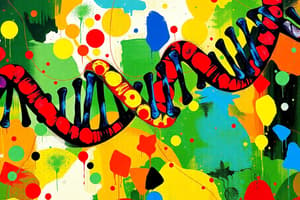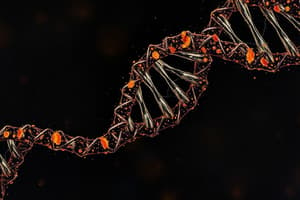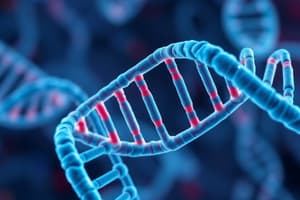Podcast
Questions and Answers
During eukaryotic DNA replication, what would happen if primase was non-functional?
During eukaryotic DNA replication, what would happen if primase was non-functional?
- Telomeres would be synthesized at an accelerated rate to compensate.
- Replication would stall because DNA polymerase requires a primer to initiate synthesis. (correct)
- Replication would proceed normally using an alternative enzyme.
- DNA polymerase would directly initiate replication without a primer.
Why do telomeres present a unique challenge during DNA replication, particularly in linear chromosomes?
Why do telomeres present a unique challenge during DNA replication, particularly in linear chromosomes?
- Telomeres interfere with the binding of DNA polymerase, slowing down replication.
- The removal of RNA primers at the ends of linear chromosomes leads to a gap that cannot be filled, causing chromosome shortening. (correct)
- The sequence of telomeres prevents proper unwinding of the DNA double helix.
- Telomeres are more susceptible to mutations due to their repetitive sequences.
What is the primary function of the G-rich overhang found at the end of telomeres?
What is the primary function of the G-rich overhang found at the end of telomeres?
- To serve as a binding site for histone proteins to condense DNA.
- To protect the ends of chromosomes from degradation and repair mechanisms. (correct)
- To initiate DNA replication at the telomere region.
- To prevent the formation of t-loop structures.
How do telomeres mitigate the cellular response to single-stranded DNA breaks?
How do telomeres mitigate the cellular response to single-stranded DNA breaks?
Given that human telomeres consist of the repeating sequence 5'-TTAGGG-3', what sequence would you expect to find on the complementary strand of the double helix?
Given that human telomeres consist of the repeating sequence 5'-TTAGGG-3', what sequence would you expect to find on the complementary strand of the double helix?
What is the primary role of DNA glycosylases in DNA repair?
What is the primary role of DNA glycosylases in DNA repair?
How does p53 halt cell cycle progression in response to DNA damage?
How does p53 halt cell cycle progression in response to DNA damage?
Why are ATM and ATR kinases important in the cellular response to DNA damage?
Why are ATM and ATR kinases important in the cellular response to DNA damage?
What distinguishes Non-Homologous End Joining (NHEJ) from Homologous Recombination (HDR) in DNA repair?
What distinguishes Non-Homologous End Joining (NHEJ) from Homologous Recombination (HDR) in DNA repair?
During which phase(s) of the cell cycle is Homologous Recombination (HDR) most likely to occur and why?
During which phase(s) of the cell cycle is Homologous Recombination (HDR) most likely to occur and why?
What is the potential consequence of errors during the repair of double-strand breaks, particularly involving chromosome fusion?
What is the potential consequence of errors during the repair of double-strand breaks, particularly involving chromosome fusion?
How does the Mdm2 complex regulate p53 levels in normal, unstressed cells?
How does the Mdm2 complex regulate p53 levels in normal, unstressed cells?
If a cell has a defect preventing it from properly executing homologous recombination, what is a likely consequence?
If a cell has a defect preventing it from properly executing homologous recombination, what is a likely consequence?
How do interstrand crosslinks differ from point mutations in terms of DNA damage severity?
How do interstrand crosslinks differ from point mutations in terms of DNA damage severity?
How can defects in DNA polymerase contribute to genetic diseases, such as Huntington's disease?
How can defects in DNA polymerase contribute to genetic diseases, such as Huntington's disease?
What is the primary function of the shelterin complex in telomere maintenance?
What is the primary function of the shelterin complex in telomere maintenance?
Which of the following components are essential for telomerase activity?
Which of the following components are essential for telomerase activity?
How does telomerase address the issue of chromosome shortening during DNA replication?
How does telomerase address the issue of chromosome shortening during DNA replication?
What is the consequence of a mutation in a gene that regulates the shelterin complex?
What is the consequence of a mutation in a gene that regulates the shelterin complex?
A researcher observes a cell with short telomeres that has lost its normal function. What is the term for this phenomenon?
A researcher observes a cell with short telomeres that has lost its normal function. What is the term for this phenomenon?
A point mutation results in the conversion of adenine to guanine. What type of mutation is this?
A point mutation results in the conversion of adenine to guanine. What type of mutation is this?
Which of the following DNA damages is considered the MOST deleterious to the cell?
Which of the following DNA damages is considered the MOST deleterious to the cell?
After UV exposure, a cell has formed thymine dimers. Which of the following describes this damage?
After UV exposure, a cell has formed thymine dimers. Which of the following describes this damage?
During DNA replication, a guanine base is oxidized to 8-oxodG, which then mispairs with adenine. If this error is not corrected, what will be the resulting mutation after cell division?
During DNA replication, a guanine base is oxidized to 8-oxodG, which then mispairs with adenine. If this error is not corrected, what will be the resulting mutation after cell division?
In mismatch repair, how does the repair system recognize the newly synthesized strand in prokaryotes?
In mismatch repair, how does the repair system recognize the newly synthesized strand in prokaryotes?
Flashcards
DNA Polymerase Direction
DNA Polymerase Direction
DNA polymerase reads the template strand in the 3' to 5' direction.
DNA Replication Requirements
DNA Replication Requirements
For DNA replication, you need a DNA template, dNTPs, enzymes, and a primer.
Telomere Purpose
Telomere Purpose
Telomeres protect the ends of chromosomes and solve the 'end-replication problem'.
Human Telomere Sequence
Human Telomere Sequence
Signup and view all the flashcards
Telomere T-loops
Telomere T-loops
Signup and view all the flashcards
DNA Glycosylases
DNA Glycosylases
Signup and view all the flashcards
Endonuclease
Endonuclease
Signup and view all the flashcards
Exonuclease
Exonuclease
Signup and view all the flashcards
P53
P53
Signup and view all the flashcards
P21 (CDK inhibitor)
P21 (CDK inhibitor)
Signup and view all the flashcards
Exogenous DNA Damage
Exogenous DNA Damage
Signup and view all the flashcards
Endogenous DNA Damage
Endogenous DNA Damage
Signup and view all the flashcards
Aneuploidy
Aneuploidy
Signup and view all the flashcards
Chromosome Rearrangements
Chromosome Rearrangements
Signup and view all the flashcards
NHEJ (Non-Homologous End Joining)
NHEJ (Non-Homologous End Joining)
Signup and view all the flashcards
G-rich overhang
G-rich overhang
Signup and view all the flashcards
Shelterin complex
Shelterin complex
Signup and view all the flashcards
Telomerase
Telomerase
Signup and view all the flashcards
TERC
TERC
Signup and view all the flashcards
TERT
TERT
Signup and view all the flashcards
Point mutation
Point mutation
Signup and view all the flashcards
Transversion
Transversion
Signup and view all the flashcards
Depurination
Depurination
Signup and view all the flashcards
Deamination
Deamination
Signup and view all the flashcards
Mismatch repair
Mismatch repair
Signup and view all the flashcards
Study Notes
- DNA replication needs DNA polymerase, subunits, and accessory factors to replicate the strand
- DNA polymerase reads the template in the 3' to 5' direction
- DNA polymerase adds to the template in the 5' to 3' direction
- Nucleases need a 3' hydroxy group to add new nucleotides to the strand
- In order to replicate new DNA, a template is necessary, along with dNTPs, enzyme, and a primer
Replication of DNA
- Eukaryotes use DNA polymerases 1 and 3 in DNA replication
- DNA polymerase reads the template in the 3' to 5' direction
- DNA polymerase adds the template in the 5' to 3' direction
- DNA polymerase families include A, B, C, D, X and Y
End Replication Problem
- Priming is necessary for DNA polymerase and thus usually involves RNA, which is later degraded, resulting in a region of ssDNA that can't be replicated
- ssDNA degrades via DNA repair machinery, leading to shorter chromosomes after each replication round
- Around 30 to 50 replication cycles, the cell can undergo chromosome shortening, causing cells to undergo replicative senescence and cell cycle arrest
- Telomeres are there to solve the problems of end replication
- RNA primers need to be removed, which leaves a gap at the end of chromosome
- The above isn't an issue with circular DNA
- The ssDNA gap causes cells to respond
- DNA replication takes place on 2 strands, which each have different polarity
- Polarity introduces end replication problem
Telomeres
- Telomeres serve two functions including protecting the ends of a chromosome and provide a way of overcoming the end-replication problem
- Telomeres can shorten normally with aging, dysfunction contributes to age-related disease, genome instability, and cancer
- Human telomeres consist of many repeats of the sequence 5' TTAGGG 3'
- Consists of formation, function to protect the chromosomes end, telomeric shortening contributes to ageing, and consists of 5' TTAAGGG 3'
- G-rich strand extends 5' to 3' towards a chromosome end and terminates in a ss region called the G-rich overhand
- Repetitive sequence varies in length in species, from 50 bp to 30,000 bp (30 kb)
- G-rich srand: strand that extends 5' to 3' towards a chromosome's end and terminates in a small single stranded region named the G-rich overhang
- Length of telomere sequences on chromosomes differ
Telomeres Protection
- G-rich overhang is processed into a t-loop, through base pairing between the ss G-overhang and the ds region of telomere DNA
- Telomere t-loop configuration helps prevent the inappropriate activation of the cell's DNA damage response (nuclease activity and cell death)
- telomeres form loop structures such as a T-loop, and a D-loop
- Cells do not like having single stranded DNA
- Telomeres, forms the t-loop structures to compensate; structure contains repetitive G-rich overhangs that loop over
- D-loop is a displacement loop, or when non-sisters exchange genetic material
Telomere Binding
- Telomere-binding proteins are for telomere function and are known as shelterin proteins
- Shelterin's 3 classes: end-binding proteins, dsDNA-binding proteins, and telomere-associated proteins that don't bind DNA.
- There's also POT1, TIN2, TPP1, RAP1, TRF2 TRF1
- POT1 binds ss G-overhangs and associates with TPP1
- TRF1 + TRF2: binds along length of double-stranded telomeric DNA and interacts with TIN2
- The t-loop is stabilized by the proteins, which protect the ends, and they regulate their length by controlling the access of its telomerase
- The regions for protein binding is the shelterin complex and includes those that bind to the end, those that bind to the double stranded DNA itself, and telomere-associated proteins.
Telomerase
- Telomere length is maintained by the enzyme telomerase
- Telomerase: large ribonucleoprotein (RNP) consists of telomerase reverse transcriptase (TERT) enzyme & non-coding templating RNA (TERC, humans)
- Telomerase uses 3'-OH of G-overhang to bind complementary RNA that acts as temp for new DNA, it then adds a sequence to the G-overhang
- Opposite strand is filled in via DNA polymerase
- Two parts that are important to telomerase activity are TERT ,telomerase reverse transcriptase and TERC, non-coding template
- Telomerase adds a 6-nucleotide sequence to the end of the chromosomes
- Cells that aren't continually dividing stabilize their tips with t-loops
- One aspect includes a gap that can't be filled by nucleotides
- Telomerase extends the G-overhang, thus the other end can be filled in
Telomere Maintenence
- Telomerase activity is regulated tightly and is highly expressed in stem cells and germ line
- Telomeres shrink with age, especially in rapidly cycling cells like hematopoietic, and epidermal stem cells
- Senescence or cell death be triggered w as little as 5 of 46 telomeres that are super short
- Mutation in genes that encode the RNA or telomere proteins can lead to dyskeratosis, aplastic anemia, idiopathic pulmonary fibrosis.
- Multi-generational consequences can happen if the germ lines telomeres affected
- Mutation in a gene regulates the shelterin complex is important for recruiting tips for extending telomerase
DNA Damage
- DNA Damage is either repaired or becomes a mutation during replication
- Scale and type can create point mutations which affect only a few nuceleotides or chromosome or karyotype altering which changes a gene number
- Source can stem from normal error in normal process, erros caused by defective process, or environmental mutagens such as chemical, UV, radiation and heavy metals
- Phenotypic consequence can be thought of by the scale and source of damage, Point Mutations are smaller w proofreading activity and need considering of whether the non coding region
Point Mutation
- Point mutations can be substitution, deletions, or insertion
- Substitution: Purine to pyrimidine is a transversion whereas A to G or C to T is a transition, which is purine to purine or pyrimidine to pyrimidine
- C-T transitions happen twice as often in humans than all other mutations together
Single Nucleotide Lesions
- Dividing cells may be subject to ~70,000 instances of DNA damages daily
- Most of these get repaired by BER pathway
- Type of lesions are Hydrolysis, Methylation, Oxidation w 9,000 to 10,000 being the common issue
- Damage can be oxidation, hydrolysis, and methylation which change their substituents
DNA Repair
- Alterations that require repair can involve oxidation, methylation, or hydrolysis
- Some metabolism byproducts may come from reactive oxygen species
- In Deupruination, the nucleotide loses its nitrogenous base and in deamination a amino group gets removed leading to changes
- DNA also gets damages in sugar structure or with Thymidine Dimers as well Oxidation damage
- Oxidative damage: 8-oxodG mispairs with A Normal G-C → mutant T-A after replication
- ds breaks are the most dangerous, caused by ionization radiation so the mechan is to involve homologous recombination for the repair.
- UV light bad for DNA by making dimers instead of watson crick
Normal Error Process
- DNA polymerase has high fidelity, making few errors in nucleotide matching
- DNA polymerase has a proofreading mechanism, where it will stop if the wrong nucleotide is inserted
- The 3' to 5' exonuclease recognizes and excises mismatches
- Eukaryotic DNA polymerases make errors that can range from 10^4 to 10^6
- Exonuclease proofreading decreases the chance of making mistakes w low count in bacteria
Errors and Defects
- Errors cause mutations and defects when cancerous
- Mismatch repari involves the MutSa-MutLa pathway, to help repair replication erros as a vast majority
- Mismatch repair pathway: in cells that are active & dividing with a main goal of fixing majority of error
- Recruits accessory proteins: cut strand and mismatches where new repalce from DNA as well nick sealed by DNA ligase
- PCNA the cap based on the location problem distinguished to
The Repair and Damage
- nucleotide mismatches, double-strand breaks (DSBs), base damage , sugar damage, DNA cross-linking are all types od DNA damage
Base Excision Repair
- Repairs include DNA glycosylases (11 in mammals), recognize a specific type of altered base in DNA and catalyze its hydrolytic removal
- Endonuclease cuts phosphodiester backbone such as where the resulting gap is repaired can be found for differentiated cells and monitor through monitoring as Rracil because it's been deaminated and recruit is the DNA in it. Exonuclease cuts the nucleotides, DNA Ligase Repairs the strand.
Nucleotide Exision Repair
- repairs the damage caused by almost any large change in the structure of the DNA double helix
- Process Involves XPC/RAD23B recognition, Nick recognition, TFIIH strand opening with exonucleases filling and ligating up via ployremase.
Stop Signal
- Mutating and division causes a cell's DNA damage causing a signaling pathway
The Kinase
- kinases can be ATM or ATR, which recruit Chk1 protein kinases, the phosphoralation of the p53 which normally is in ubiquitylation and destruction
- Important not to pass to the next division
- P53 a tumer suppressor, tells the cells where stop / repair normally low cells as the Mdm2 keeps is going, which inhibits the Cyclin which halts everything.
- ATR and ATM kinases reactivate in response to DNA damage and phosphoralate P53
- ATR / ATM kinases that can either single or or double the strand and bind to many gens
Errors Caused by Defect
- Mutate from replication can lead to various diseases that causes issues for human
Trinucleotide repeater
- Leads to Huntington Disease which leads neuro issues and survival issues later on with expanded of glutamine toxicity
- Polymerase slips
- Defect leads to expansion on the chromosome to continue for Huntington
Strands
- Cross links forms between DNA strands which with blocks replications and transcript
Double Strand
double-strand breaks(DSBs)
- held together by hydrogren bnds and covalently with scale
- Aneuploidy, less or more chromosomes than normal from meiosis
Karyotypes Reveal Issues
- Karyotype reveals Chromosomal abnormalities such as translocations, inversions, and aneuploidys such as Down’s syndrome, Turner’s syndrome, and Klinefelter’s syndrome.
Cancer
- cancer from chromosome and abnormality:duplication,deletion or rearrangements with heterogeneity
Double Stand Breaks
- Can cause repairs by
- HDR Homologous directed repair AKA homologous recombination that has errors and has a template. Uses identical sister chromosomes that can cause similar homolouges.
- NHEJ Non-Homologous End Join - end of life coming and fusings causing nucleotides badness that mutates.
Somatic Translocations
- human cancers such philidelphi Chromosome can cause repairs of break leads to fusion of new genes
Studying That Suits You
Use AI to generate personalized quizzes and flashcards to suit your learning preferences.




